Spatial Pattern Analysis of a Water-Related Ecosystem Service and Evaluation of the Grassland-Carrying Capacity of the Heihe River Basin under Land Use Change
Abstract
:1. Introduction
2. Materials and Methods
2.1. Study Area
2.2. Operational Framework of the Spatial Pattern of WESs and Grassland-Grazing Capacity
2.3. Land-Use Change
2.4. Modeling WESs
2.5. Determination of the Suitable Grazing Area and Carrying Capacity
2.6. Data Requirement and Preparation
3. Results
3.1. Land-Use Change
3.2. The Distribution Change of Grassland Coverage
3.3. Ecosystem Services Change
3.3.1. Water Yield
3.3.2. Soil Retention
3.3.3. Soil Erosion
3.3.4. Nitrogen and Phosphorus Export
3.4. Identification of Suitable Grazing Areas
3.5. Identification of Suitable Carrying Capacity
3.6. Tradeoff Analysis
4. Discussion
4.1. Changes in Land Use and the Distribution of Grassland Coverage
4.2. Potential Water-Related Ecological Vulnerability
4.3. Grassland Protection and the Healthy Development of Animal Husbandry
4.4. Limitation and Innovation
5. Conclusions
Supplementary Materials
Author Contributions
Funding
Institutional Review Board Statement
Informed Consent Statement
Acknowledgments
Conflicts of Interest
References
- Sannigrahi, S.; Zhang, Q.; Pilla, F.; Joshi, P.K.; Basu, B.; Keesstra, S.; Roy, P.S.; Wang, Y.; Sutton, P.C.; Chakraborti, S.; et al. Responses of ecosystem services to natural and anthropogenic forcings: A spatial regression based assessment in the world’s largest mangrove ecosystem. Sci. Total Environ. 2020, 715, 137004. [Google Scholar] [CrossRef]
- Zommers, Z.; Wrathall, D.; van der Geest, K. Loss and Damage to Ecosystem Services. Available online: http://collections.unu.edu/view/UNU:2860 (accessed on 22 December 2014).
- Zhang, L.X.; Fan, J.W.; Zhou, D.C.; Zhang, H.Y. Ecological Protection and Restoration ProgramReduced Grazing Pressure in the Three-River Headwaters Region, China. Rangel. Ecol. Manag. 2017, 70, 540–548. [Google Scholar] [CrossRef]
- Bai, Y.; Jiang, B.; Alatalo, J.M.; Zhuang, C.; Wang, X.; Cui, L.; Xu, W. Impacts of land management on ecosystem service delivery in the Baiyangdian river basin. Environ. Earth Sci. 2016, 75, 258. [Google Scholar] [CrossRef]
- Peters, M.K.; Hemp, A.; Appelhans, T.; Becker, J.N.; Behler, C.; Classen, A.; Detsch, F.; Ensslin, A.; Ferger, S.W.; Frederiksen, S.B. Climate–land-use interactions shape tropical mountain biodiversity and ecosystem functions. Nature 2019, 568, 88–92. [Google Scholar] [CrossRef] [PubMed]
- Mastrorilli, M.; Rana, G.; Verdiani, G.; Tedeschi, G.; Fumai, A.; Russo, G. Economic Evaluation of Hydrological Ecosystem Services in Mediterranean River Basins Applied to a Case Study in Southern Italy. Water 2018, 10, 16. [Google Scholar] [CrossRef] [Green Version]
- Aneseyee, A.B.; Soromessa, T.; Elias, E. The effect of land use/land cover changes on ecosystem services valuation of Winike watershed, Omo Gibe basin, Ethiopia. Hum. Ecol. Risk Assess. Int. J. 2020, 26, 2608–2627. [Google Scholar] [CrossRef]
- Lafuite, A.S.; Denise, G.; Loreau, M. Sustainable Land-use Management Under Biodiversity Lag Effects. Ecol. Econ. 2018, 154, 272–281. [Google Scholar] [CrossRef] [PubMed]
- Alves, L.A.; Denardin, L.G.D.; Martins, A.P.; Anghinoni, I.; Carvalho, P.C.D.; Tiecher, T. Soil acidification and P, K, Ca and Mg budget as affected by sheep grazing and crop rotation in a long-term integrated crop-livestock system in southern Brazil. Geoderma 2019, 351, 197–208. [Google Scholar] [CrossRef]
- Pittarello, M.; Probo, M.; Perotti, E.; Lonatii, M.; Lombardii, G.; Ravetto Enri, S. Grazing Management Plans improve pasture selection by cattle and forage quality in sub-alpine and alpine grasslands. J Mt. Sci. 2019, 16, 2126–2135. [Google Scholar] [CrossRef]
- Godde, C.; Dizyee, K.; Ash, A.; Thornton, P.; Sloat, L.; Roura, E.; Henderson, B.; Herrero, M. Climate change and variability impacts on grazing herds: Insights from a system dynamics approach for semi-arid Australian rangelands. Glob. Chang. Biol. 2019, 25, 3091–3109. [Google Scholar] [CrossRef] [Green Version]
- You, N.; Meng, J.; Zhu, L. Sensitivity and resilience of ecosystems to climate variability in the semi-arid to hyper-arid areas of Northern China: A case study in the Heihe River Basin. Ecol. Res. 2017, 33, 161–174. [Google Scholar] [CrossRef]
- Schirpke, U.; Kohler, M.; Leitinger, G.; Fontana, V.; Tasser, E.; Tappeiner, U. Future impacts of changing land-use and climate on ecosystem services of mountain grassland and their resilience. Ecosyst. Serv. 2017, 26, 79–94. [Google Scholar] [CrossRef] [PubMed]
- Zhao, M.; He, Z. Evaluation of the Effects of Land Cover Change on Ecosystem Service Values in the Upper Reaches of the Heihe River Basin, Northwestern China. Sustainability 2018, 10, 4700. [Google Scholar] [CrossRef] [Green Version]
- Zhang, J.P.; Zhang, L.B.; Liu, X.N.; Qiao, Q. Research on Sustainable Development in an Alpine Pastoral Area Based on Equilibrium Analysis Between the Grassland Yield, Livestock Carrying Capacity, and Animal Husbandry Population. Sustainability 2019, 11, 4659. [Google Scholar] [CrossRef] [Green Version]
- Yu, L.; Zhou, L.; Liu, W.; Zhou, H.K. Using Remote Sensing and GIS Technologies to Estimate Grass Yield and Livestock Carrying Capacity of Alpine Grasslands in Golog Prefecture, China. Pedosphere 2010, 20, 342–351. [Google Scholar] [CrossRef]
- Yang, S.; Bai, Y.; Alatalo, J.M.; Wang, H.; Jiang, B.; Liu, G.; Chen, J. Spatio-temporal changes in water-related ecosystem services provision and trade-offs with food production. J. Clean. Prod. 2021, 286, 125316. [Google Scholar] [CrossRef]
- Sodango, T.H.; Sha, J.; Li, X.; Noszczyk, T.; Shang, J.; Aneseyee, A.B.; Bao, Z. Modeling the Spatial Dynamics of Soil Organic Carbon Using Remotely-Sensed Predictors in Fuzhou City, China. Remote Sens. 2021, 13, 1682. [Google Scholar] [CrossRef]
- Meng, F.; Guo, J.; Guo, Z.; Lee, J.C.; Liu, G.; Wang, N. Urban ecological transition: The practice of ecological civilization construction in China. Sci. Total Environ. 2021, 755, 142633. [Google Scholar] [CrossRef]
- Meng, J.; Wu, X.; Li, Z. Land use and land cover changes in Heihe River Basin during the period of 1988–2000. Acta Sci. Nat. Univ. Pekin. 2004, 40, 922–929. [Google Scholar]
- Hu, X.; Lu, L.; Li, X.; Wang, J.; Guo, M. Land Use/Cover Change in the Middle Reaches of the Heihe River Basin over 2000–2011 and Its Implications for Sustainable Water Resource Management. PLoS ONE 2015, 10, e0128960. [Google Scholar] [CrossRef]
- Na, L.; Tai-bao, Y. Research on LUCC in middle reaches of Heihe River Basin after water redistribution. J. Desert Res. 2008, 28, 223–226. [Google Scholar]
- Xiao, S.; Xiao, H. The impact of human activity on the water environment of Heihe water basin in last century. J. Arid Land Resour. Environ. 2004, 18, 57–62. [Google Scholar]
- Li, X.; Lu, L.; Cheng, G.; Xiao, H. Quantifying landscape structure of the Heihe River Basin, north-west China using FRAGSTATS. J. Arid Environ. 2001, 48, 521–535. [Google Scholar] [CrossRef]
- Lu, L.; Li, X.; Cheng, G. Landscape evolution in the middle Heihe River Basin of north-west China during the last decade. J. Arid Environ. 2003, 53, 395–408. [Google Scholar] [CrossRef] [Green Version]
- Wang, J.; Meng, J.-j. Characteristics and tendencies of annual runoff variations in the Heihe River Basin during the past 60 years. Sci. Geogr. Sin. 2008, 28, 88. [Google Scholar]
- Zhang, H.; Shen, W.; Wang, Y.; Zou, C. Study on grassland grazing capacity in the Heihe River Basin. J. Nat. Resour. 2005, 20, 514–520. [Google Scholar]
- Cheng, G.; Li, X.; Zhao, W.; Xu, Z.; Feng, Q.; Xiao, S.; Xiao, H. Integrated study of the water–ecosystem–economy in the Heihe River Basin. Natl. Sci. Rev. 2014, 1, 413–428. [Google Scholar] [CrossRef] [Green Version]
- Bhagabati, N.K.; Ricketts, T.; Sulistyawan, T.B.S.; Conte, M.; Ennaanay, D.; Hadian, O.; McKenzie, E.; Olwero, N.; Rosenthal, A.; Tallis, H. Ecosystem services reinforce Sumatran tiger conservation in land use plans. Biol. Conserv. 2014, 169, 147–156. [Google Scholar] [CrossRef]
- Terrado, M.; Acuña, V.; Ennaanay, D.; Tallis, H.; Sabater, S. Impact of climate extremes on hydrological ecosystem services in a heavily humanized Mediterranean basin. Ecol. Indic. 2014, 37, 199–209. [Google Scholar] [CrossRef]
- Bai, Y.; Ochuodho, T.O.; Yang, J. Impact of land use and climate change on water-related ecosystem services in Kentucky, USA. Ecol. Indic. 2019, 102, 51–64. [Google Scholar] [CrossRef]
- Berta Aneseyee, A.; Noszczyk, T.; Soromessa, T.; Elias, E. The InVEST habitat quality model associated with land use/cover changes: A qualitative case study of the Winike Watershed in the Omo-Gibe Basin, Southwest Ethiopia. Remote Sens. 2020, 12, 1103. [Google Scholar] [CrossRef] [Green Version]
- Butsic, V.; Shapero, M.; Moanga, D.; Larson, S. Using InVEST to assess ecosystem services on conserved properties in Sonoma County, CAYY. Calif. Agric. 2017, 71, 81–89. [Google Scholar] [CrossRef] [Green Version]
- Nelson, E.; Mendoza, G.; Regetz, J.; Polasky, S.; Tallis, H.; Cameron, D.R.; Chan, K.M.A.; Daily, G.C.; Goldstein, J.; Kareiva, P.M.; et al. Modeling multiple ecosystem services, biodiversity conservation, commodity production, and tradeoffs at landscape scales. Front. Ecol. Environ. 2009, 7, 4–11. [Google Scholar] [CrossRef]
- Liao, J.; Wang, T.; Xue, X. Oasis evolution in the Heihe River Basin during 1956–2010. J. Desert Res. 2012, 32, 1426–1441. [Google Scholar]
- Weifeng, Q.; Yehua, S.; Bin, F.; Yahua, W. Land use change information mining in highly urbanized area based on transfer matrix: A case study of Suzhou, Jiangsu Province. Geogr. Res. 2013, 32, 1497–1507. [Google Scholar]
- Liu, R.; Zhu, D. Methods for detecting land use changes based on the land use transition matrix. Resour. Sci. 2010, 32, 1544–1550. [Google Scholar]
- Zhang, L.; Dawes, W.R.; Walker, G.R. Response of mean annual evapotranspiration to vegetation changes at catchment scale. Water Resour. Res. 2001, 37, 701–708. [Google Scholar] [CrossRef]
- ZHAO, W.; SHEN, W.; LIU, B.; LIN, N.; WANG, T. Carrying capacity of grasslands and its spatiotemporal change in Tibet, China. Chin. Sci. Bull. 2015, 60, 2014–2028. [Google Scholar]
- Holechek, J.L.; Pieper, R.D.; Herbel, C.H. Range Management: Principles and Practices, 2nd ed.; Prentice-Hall: Hoboken, NJ, USA, 1995; ISBN 01-317-44844. [Google Scholar]
- García-Ruiz, J.M. The effects of land uses on soil erosion in Spain: A review. Catena 2010, 81, 1–11. [Google Scholar] [CrossRef]
- Wang, B.; Zhang, G.h.; Shi, Y.y.; Zhang, X.; Ren, Z.p.; Zhu, L.j. Effect of natural restoration time of abandoned farmland on soil detachment by overland flow in the Loess Plateau of China. Earth Surf. Process. Landf. 2013, 38, 1725–1734. [Google Scholar] [CrossRef]
- Dowd, B.M.; Press, D.; Los Huertos, M. Agricultural nonpoint source water pollution policy: The case of California’s Central Coast. Agric. Ecosyst. Environ. 2008, 128, 151–161. [Google Scholar] [CrossRef]
- Parris, K. Impact of agriculture on water pollution in OECD countries: Recent trends and future prospects. Int. J. Water Resour. Dev. 2011, 27, 33–52. [Google Scholar] [CrossRef] [Green Version]
- Dai, G.; Ulgiati, S.; Zhang, Y.; Yu, B.; Kang, M.; Jin, Y.; Dong, X.; Zhang, X. The false promises of coal exploitation: How mining affects herdsmen well-being in the grassland ecosystems of Inner Mongolia. Energy Policy 2014, 67, 146–153. [Google Scholar] [CrossRef]
- Gunaratne, A.; Gunatilleke, C.; Gunatilleke, I.; Madawala, H.; Burslem, D. Overcoming ecological barriers to tropical lower montane forest succession on anthropogenic grasslands: Synthesis and future prospects. For. Ecol. Manag. 2014, 329, 340–350. [Google Scholar] [CrossRef]
- Cleland, E.E.; Chiariello, N.R.; Loarie, S.R.; Mooney, H.A.; Field, C.B. Diverse responses of phenology to global changes in a grassland ecosystem. Proc. Natl. Acad. Sci. USA 2006, 103, 13740–13744. [Google Scholar] [CrossRef] [PubMed] [Green Version]
- Cao, J.; Adamowski, J.F.; Deo, R.C.; Xu, X.; Gong, Y.; Feng, Q. Grassland Degradation on the Qinghai-Tibetan Plateau: Reevaluation of Causative Factors. Rangel. Ecol. Manag. 2019, 72, 988–995. [Google Scholar] [CrossRef]
- Hu, C. Present situation, problem analysis and Countermeasures of grass and livestock industry development and grassland protection and utilization in Shandan County. Gansu Anim. Husb. Vet. 2015, 45, 68–70. [Google Scholar]
- Hao, P. Research on Social Evaluation of Turning the Cultivated Land into Forests or Grasslands Project in Heihe River Basin——Take Zhangye Prefecture in Gansu Province as an Example. Res. Soil Water Conserv. 2006, 13, 204–207. [Google Scholar]
- LI, Q.-S.; Zhao, W.-Z.; MA, C.-C. Theory and application of forage and livestock coupling for mountainous-oasis-desert country in the Heihe River basin—Study of the Linze demonstration area in the middle reaches of the Heihe River basin for example. Acta Pratacultural Sci. 2004, 4, 13–20. [Google Scholar]
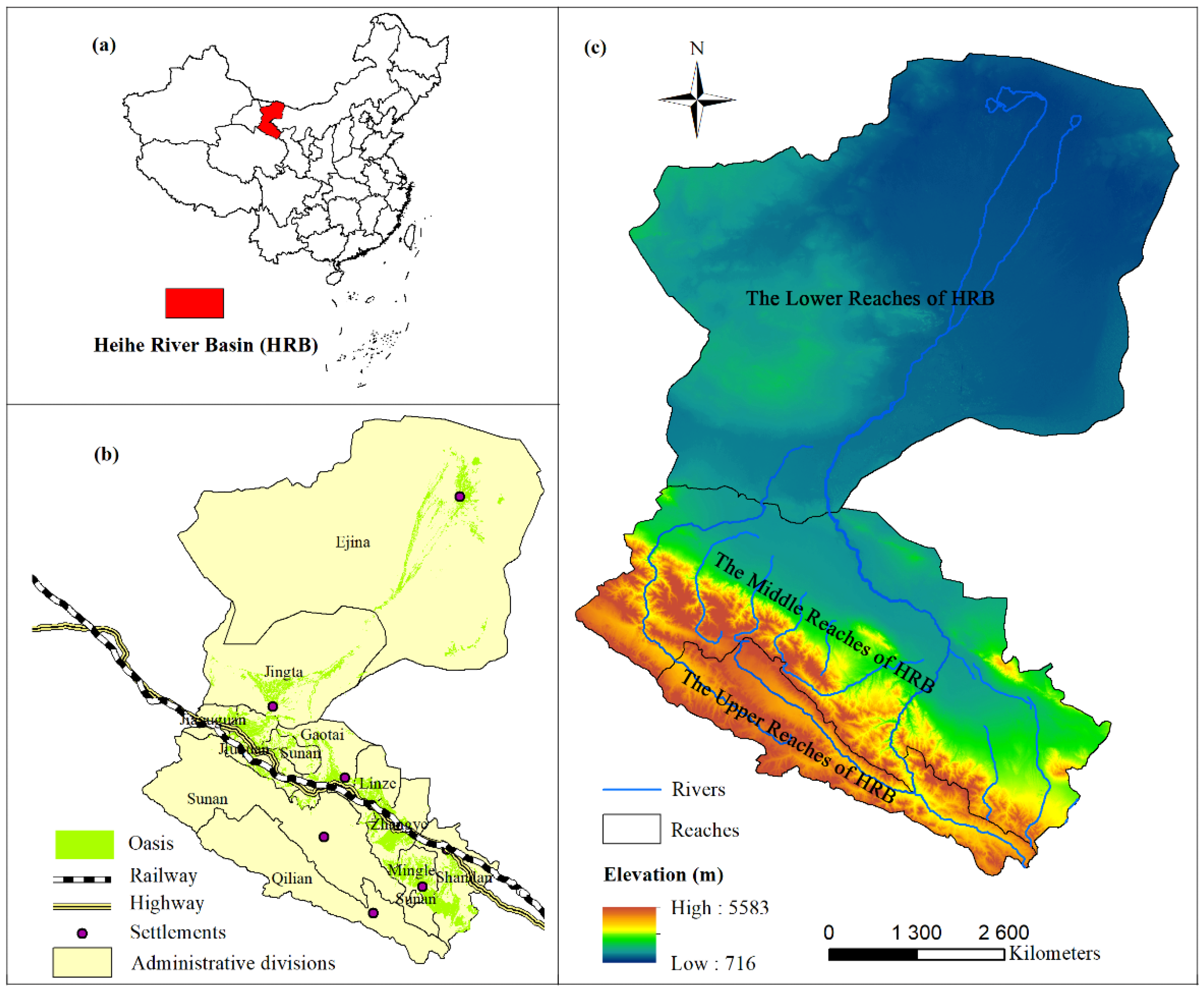
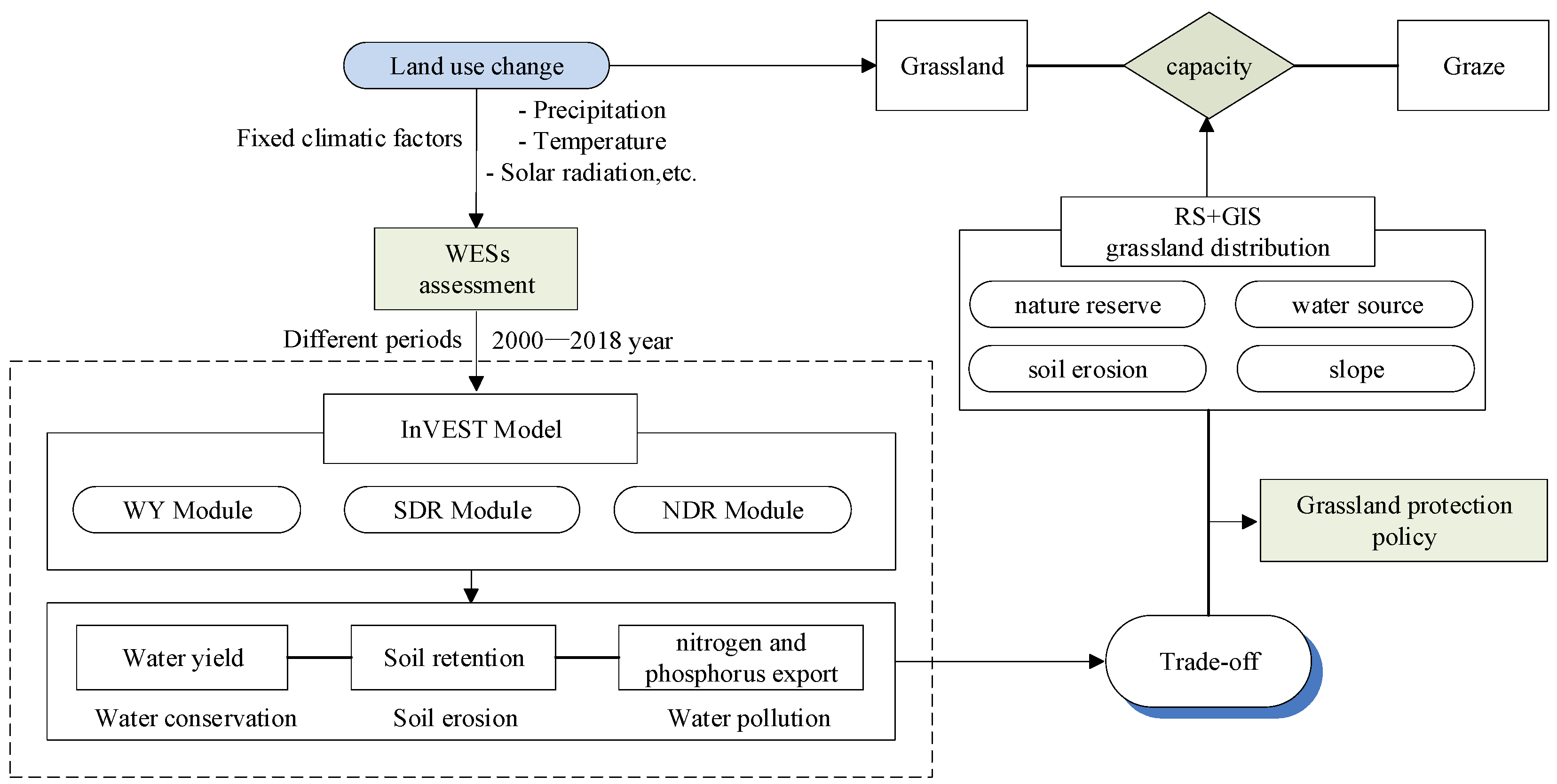
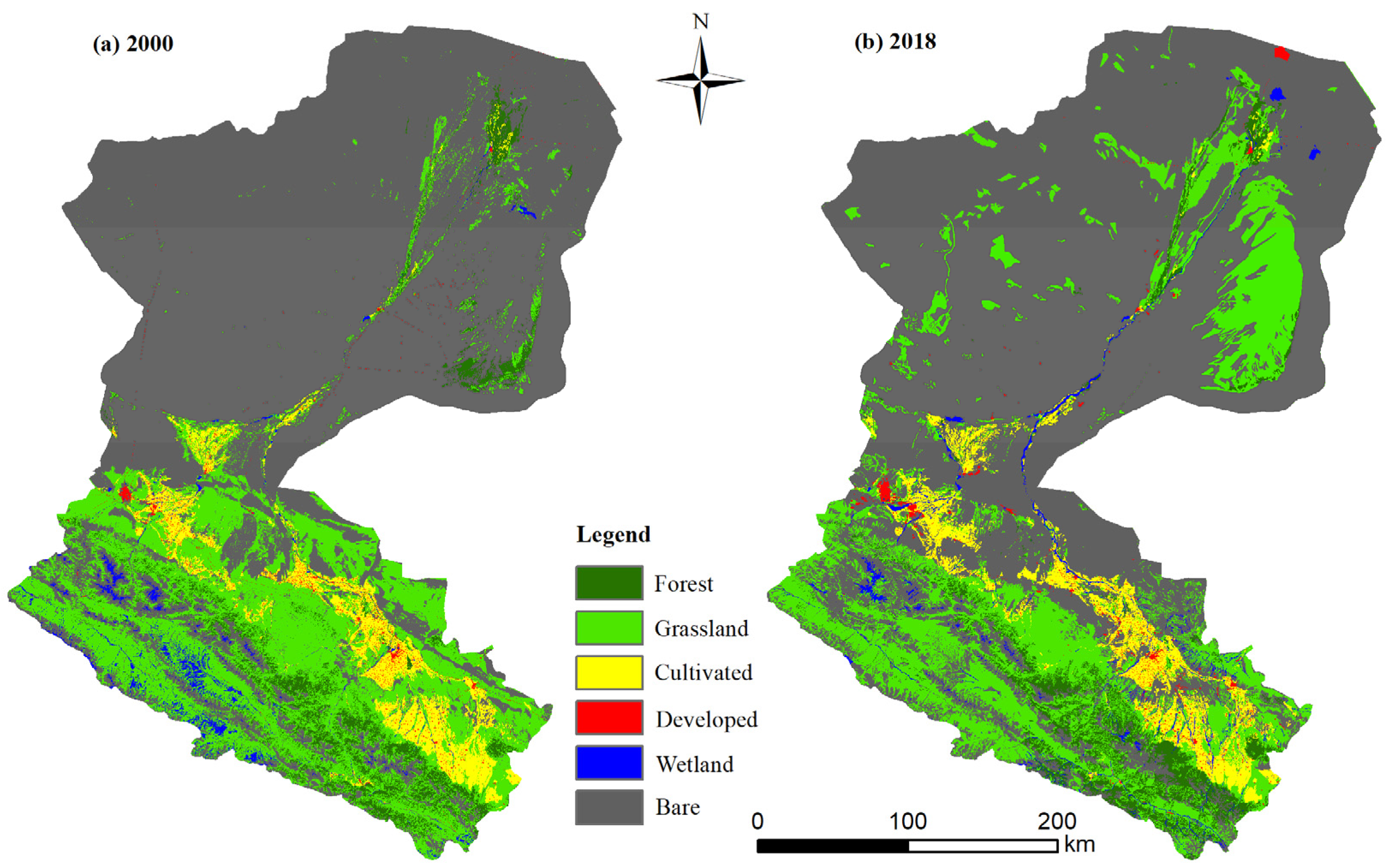
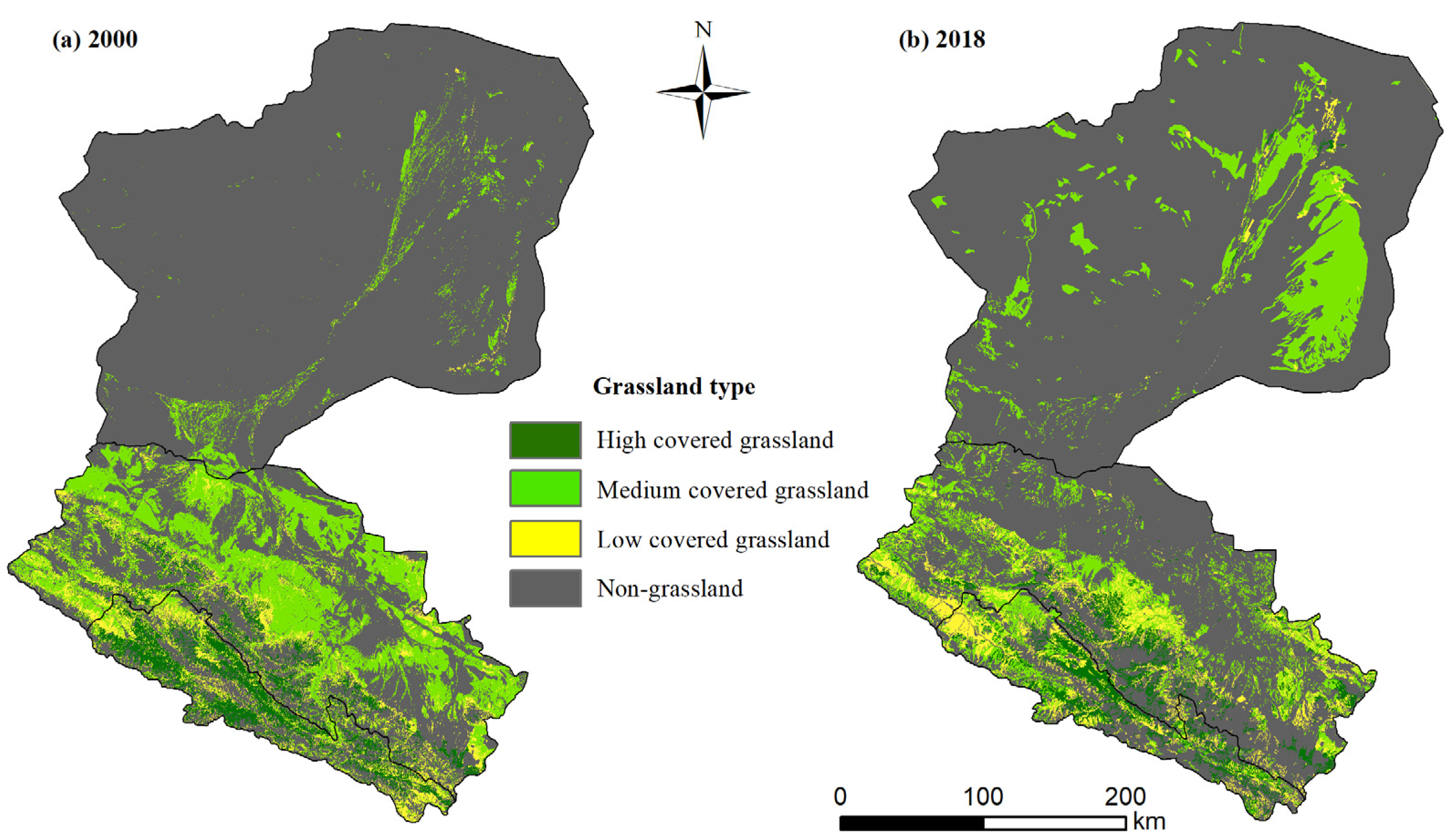
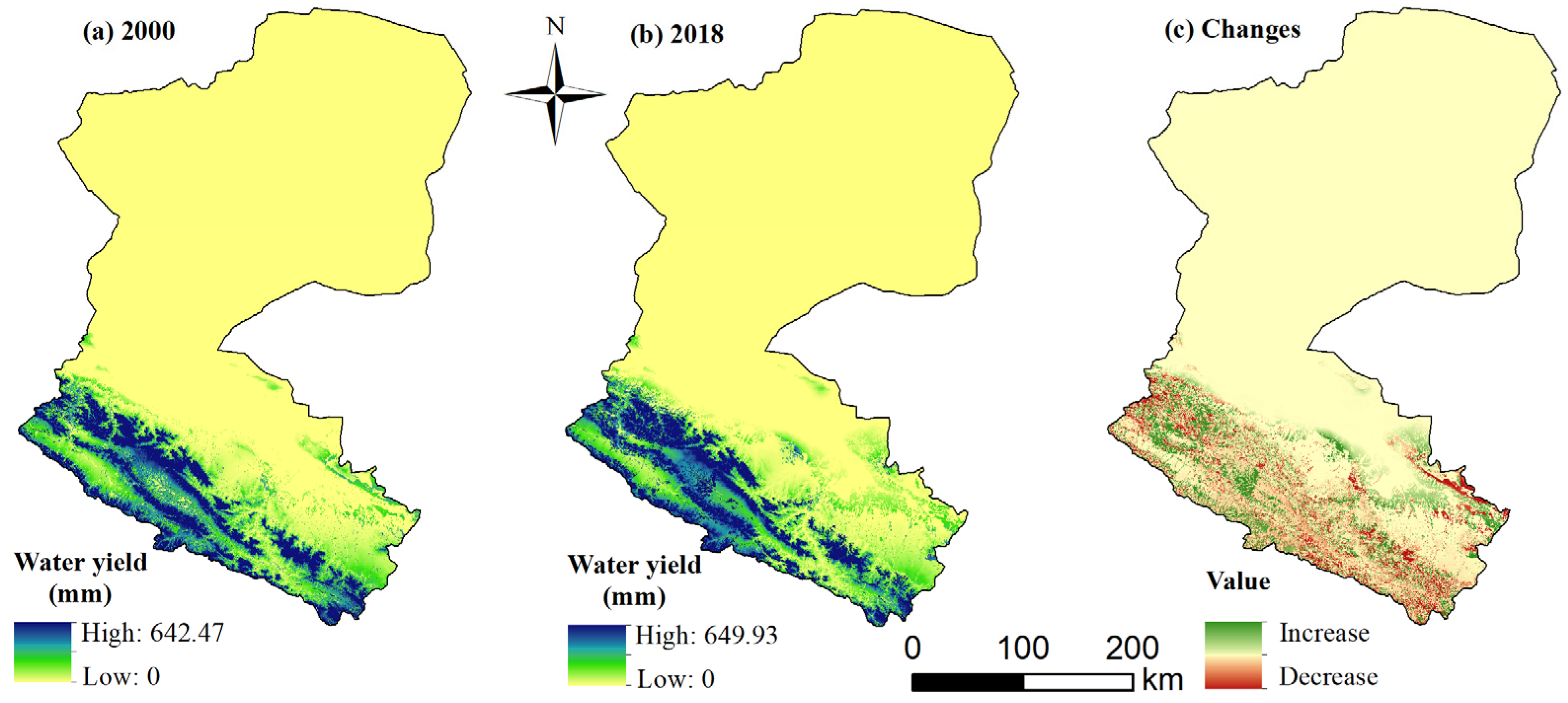
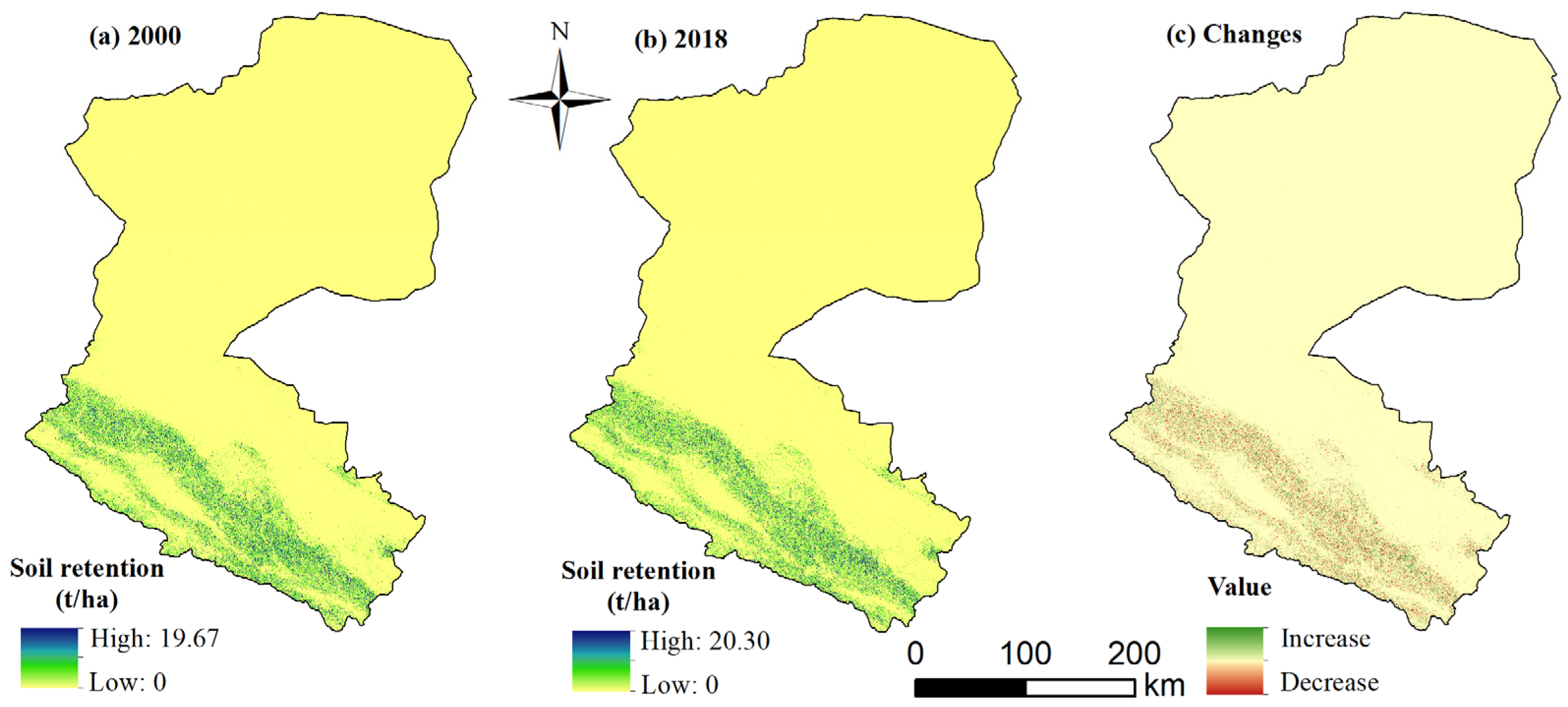
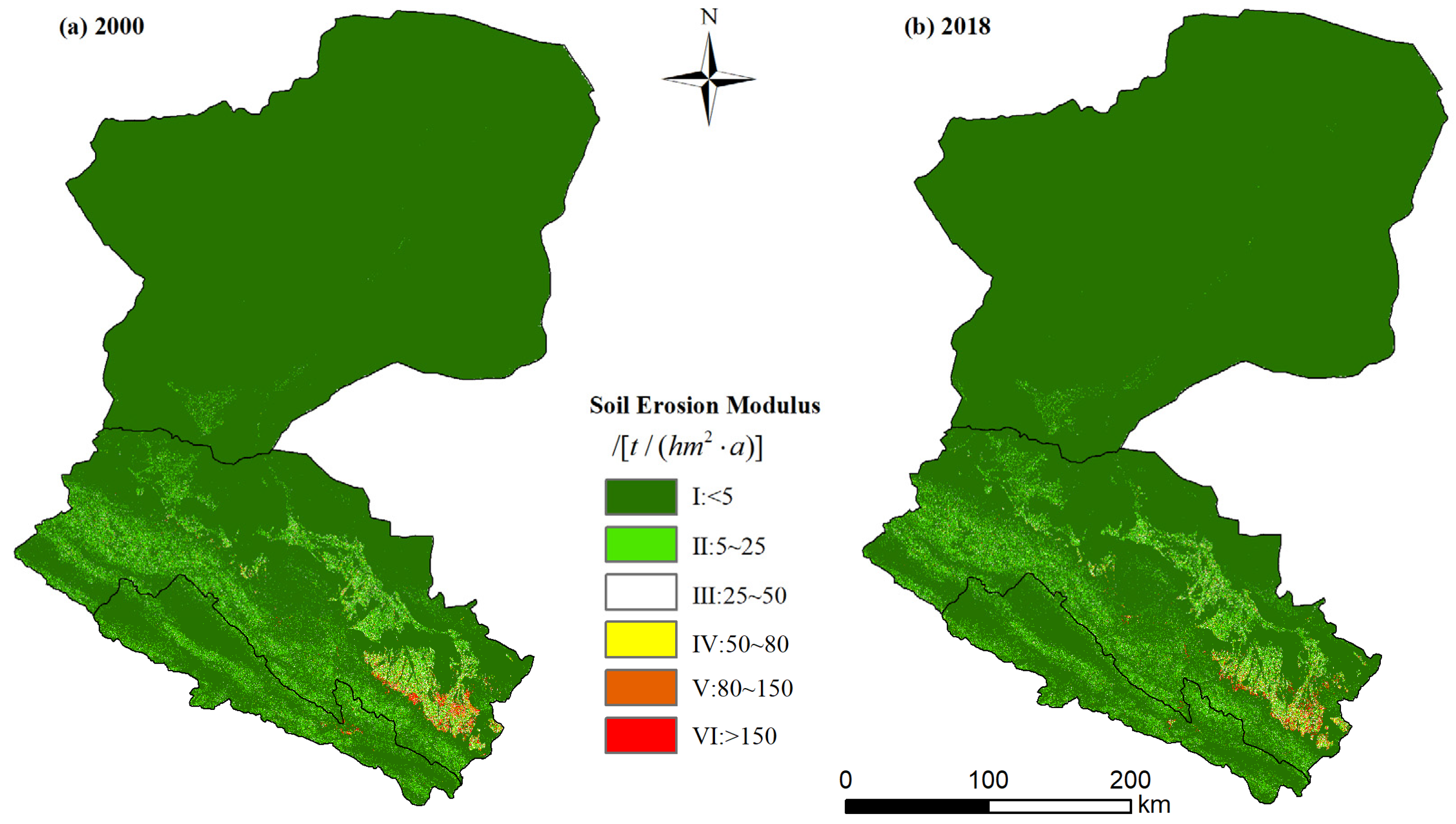
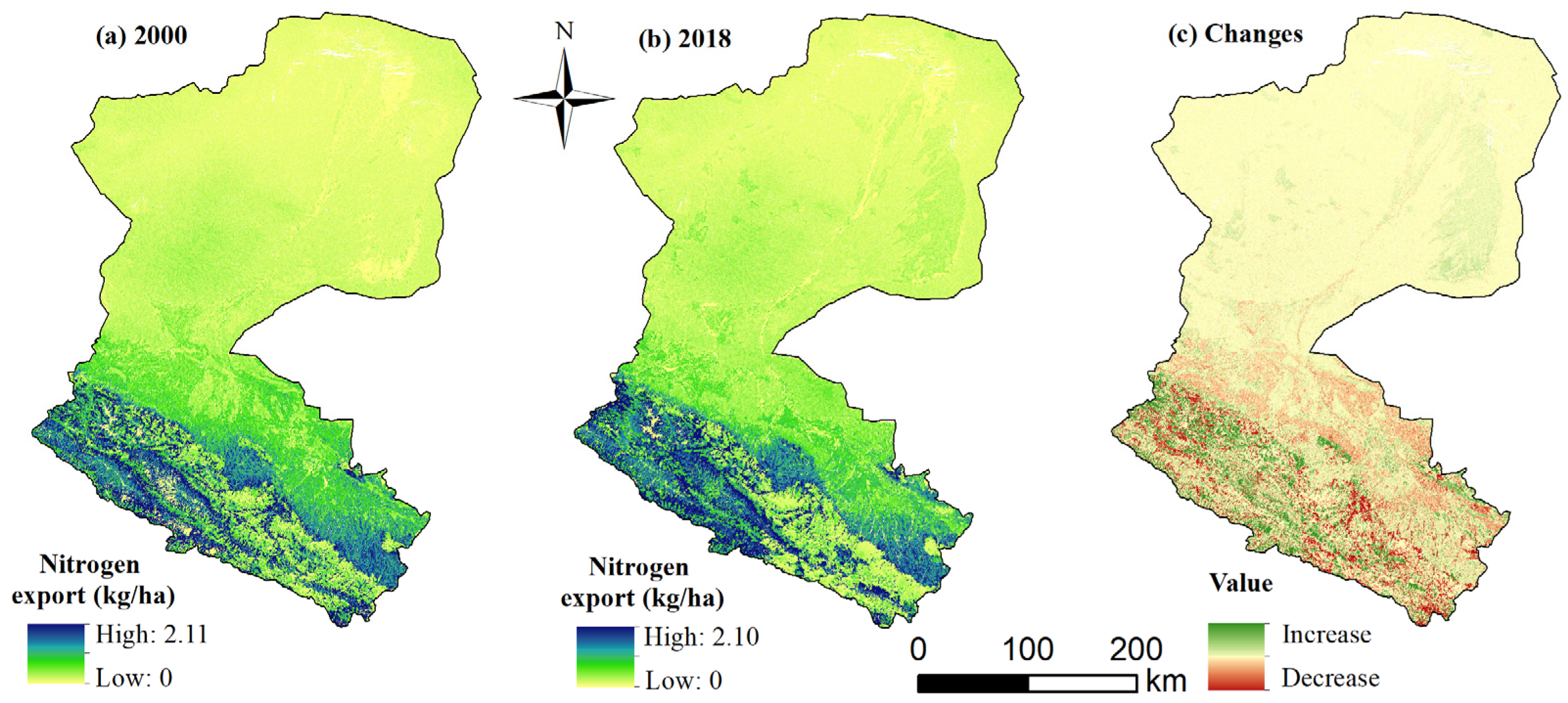
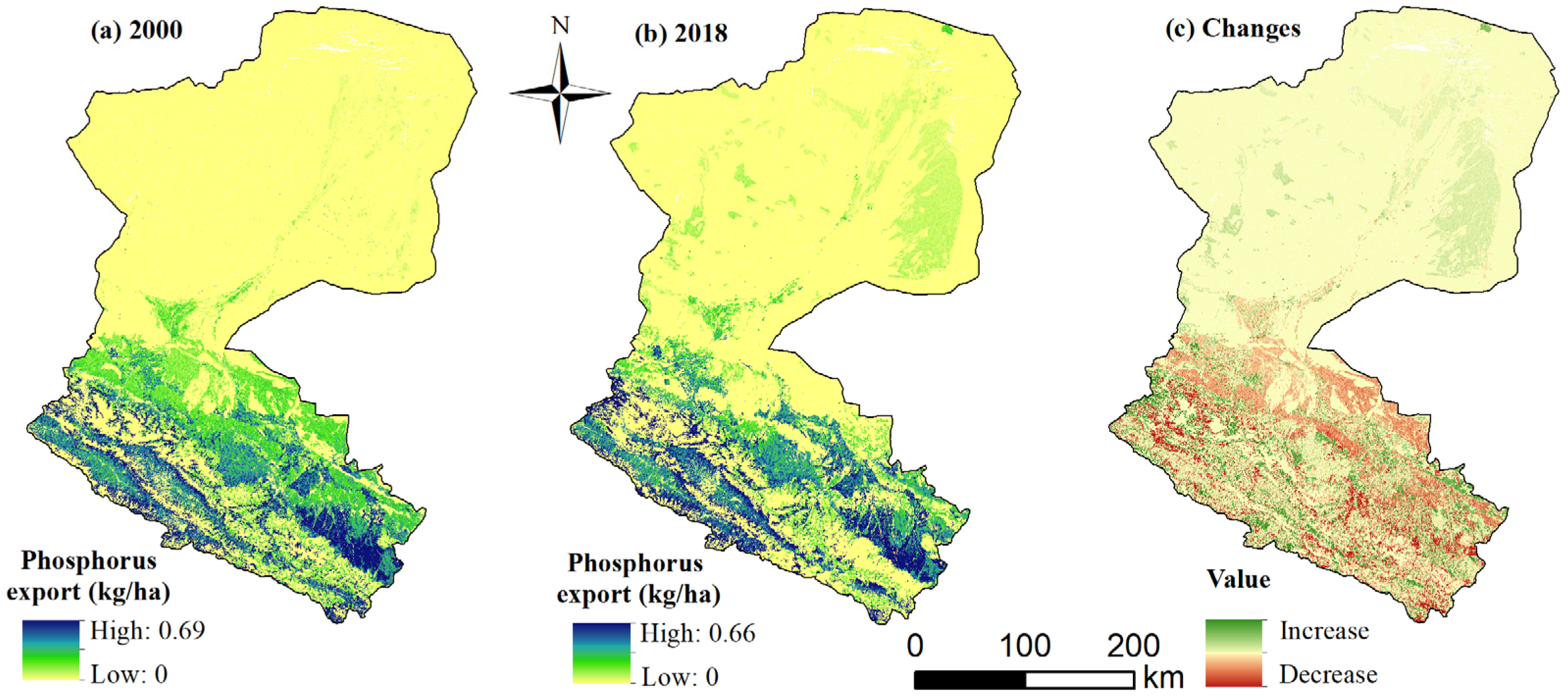
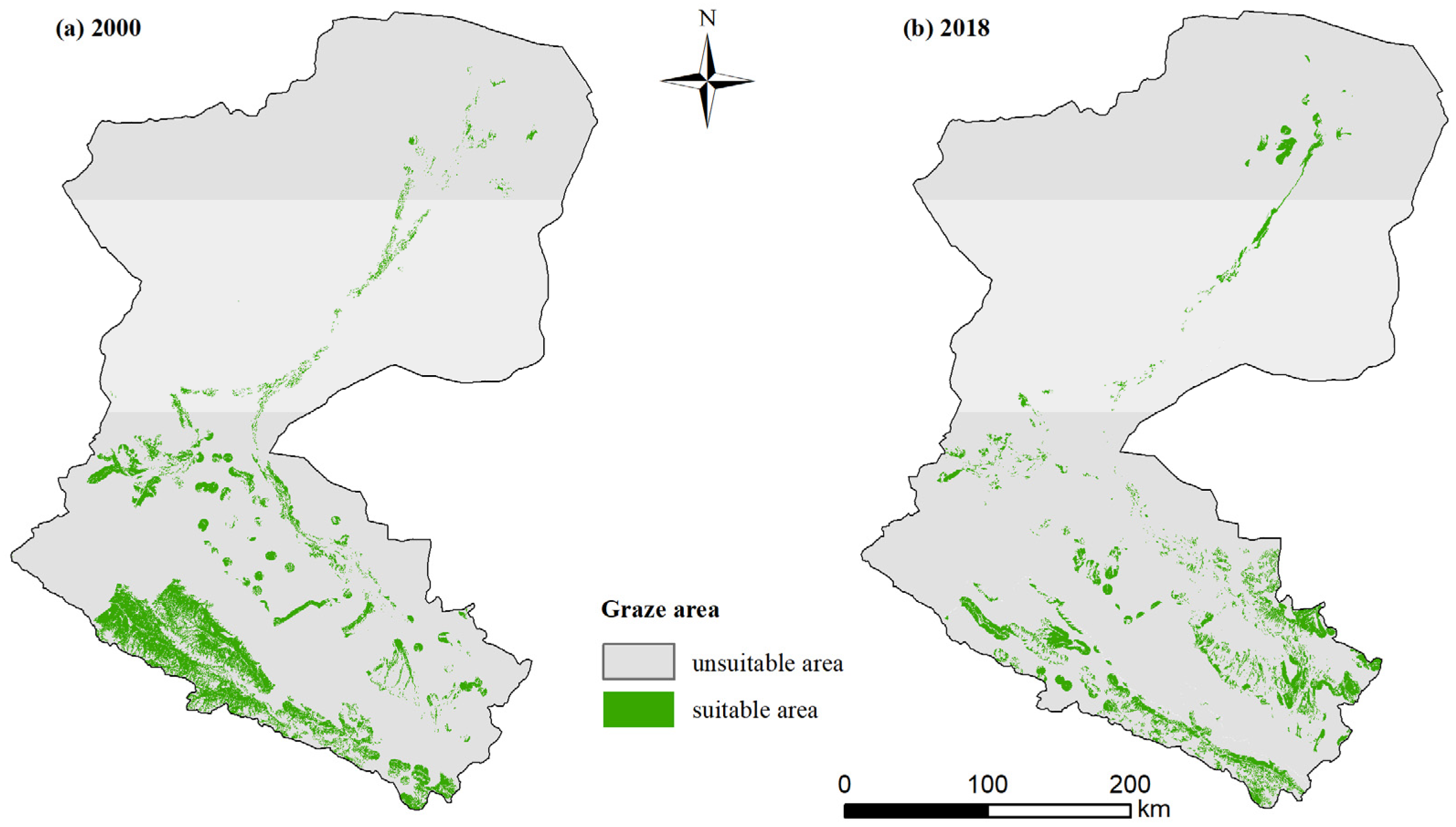
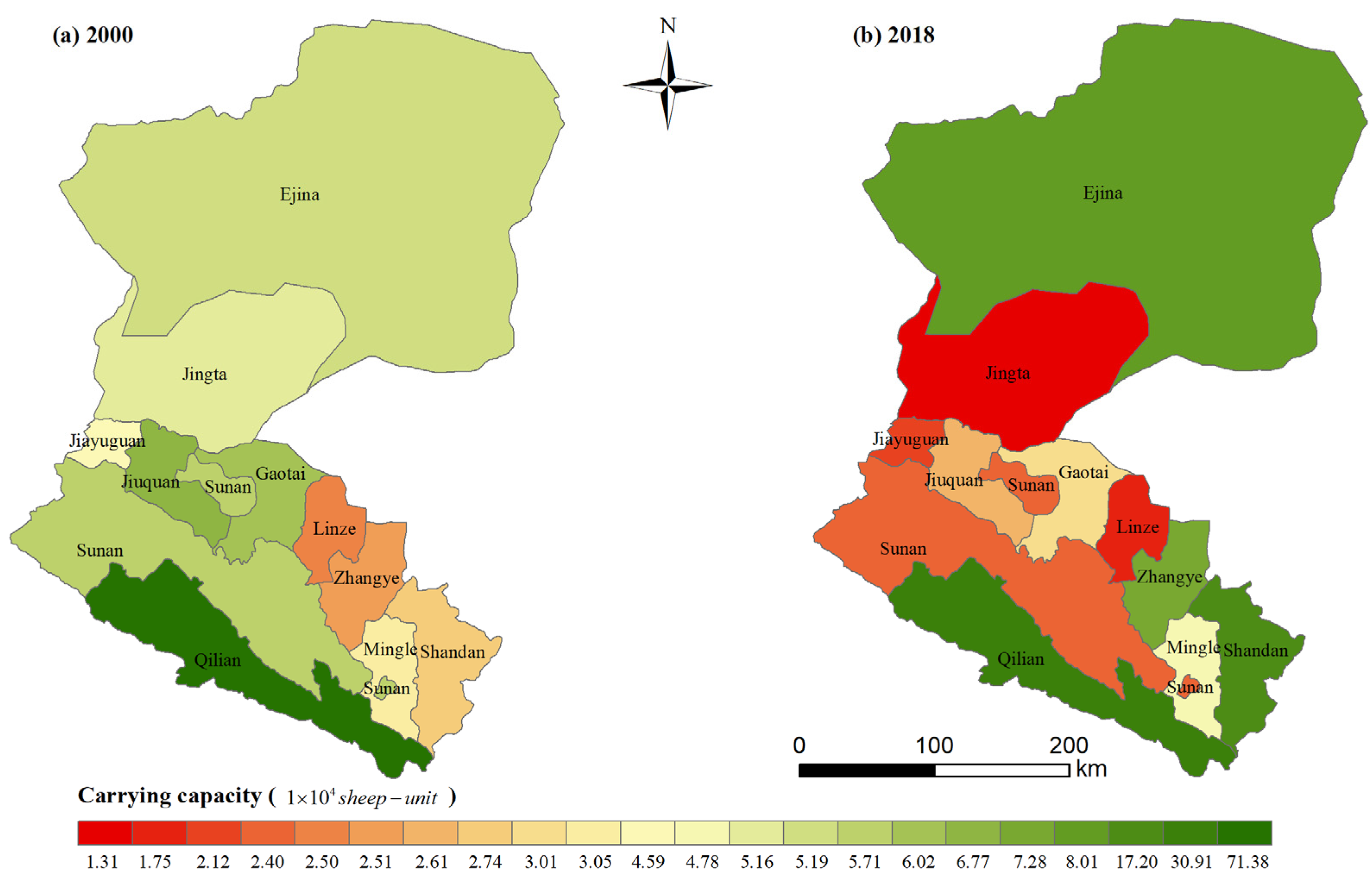
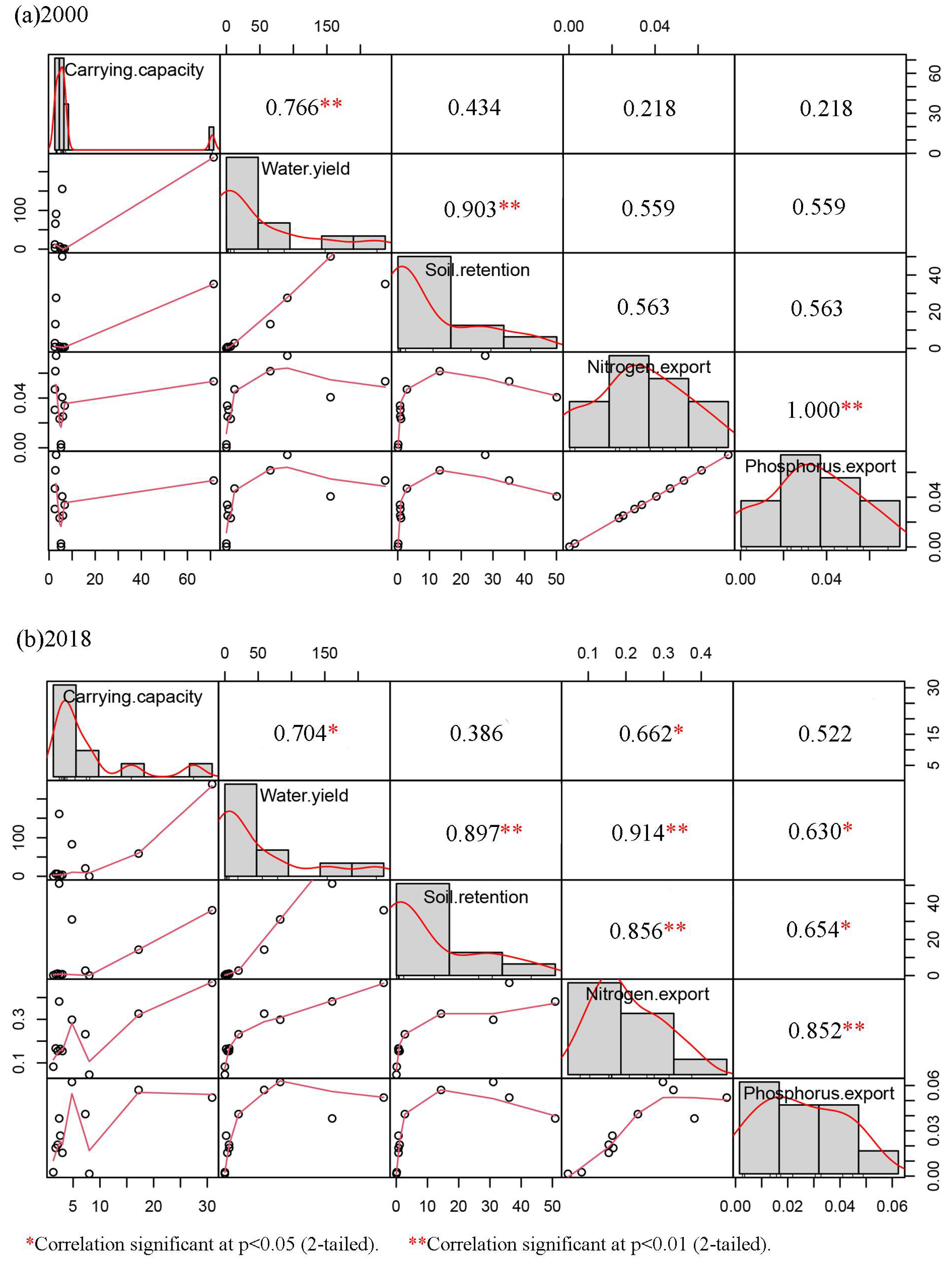
| 2018 | ||||||||
|---|---|---|---|---|---|---|---|---|
| Forest | Grassland | Cultivated | Developed | Wetland | Bare | Total | ||
| 2000 | Forest | 2754.12 | 1791.01 | 84.16 | 8.25 | 52.83 | 639.66 | 5330.03 |
| Grassland | 2435.86 | 14,855.38 | 862.93 | 199.55 | 544.55 | 10,858.44 | 29,756.71 | |
| Cultivated | 99.03 | 576.69 | 4732.79 | 237.08 | 88.54 | 332.34 | 6066.47 | |
| Developed | 9.96 | 68.13 | 305.4 | 231.78 | 9.42 | 131.98 | 756.67 | |
| Wetland | 53.19 | 647.49 | 21.17 | 2.83 | 323.21 | 532.32 | 1580.21 | |
| Bare | 505.47 | 10,685.39 | 352.03 | 187.84 | 570.31 | 72,504.95 | 84,805.99 | |
| Total | 5857.63 | 28,624.09 | 6358.48 | 867.33 | 1588.86 | 84,999.69 | 128,296.08 |
| Grassland Covered Type | Area | Percent (%) | Carrying Capacity Reference Reduced (%) | Ecological Compensation Reference Needs (%) | ||
|---|---|---|---|---|---|---|
| 2000 | 2018 | 2000 | 2018 | |||
| High | 5187.21 | 4501.80 | 4.04 | 3.51 | 15.00 | 50.00 |
| Medium | 5944.10 | 6343.97 | 4.63 | 4.95 | 25.00 | 50.00 |
| Low | 18,625.68 | 17,724.77 | 14.52 | 13.82 | 35.00 | 50.00 |
| Non-grassland | 98,541.54 | 99,679.29 | 76.81 | 77.72 | 0.00 | 0.00 |
| Water-Related Ecosystem Services | 2000 | 2018 |
|---|---|---|
| Total area of Heihe River Basin (104 km2) | 12.78 | 12.78 |
| Water yield (108 m3) | 57.68 | 58.75 |
| Soil retention (ton) | 1,534,755,667.48 | 1,579,632,228.14 |
| Soil export (ton) | 2,720,496.55 | 2,583,635.23 |
| Soil loss (ton) | 1,537,476,164.03 | 1,582,215,863.37 |
| Nitrogen load (ton) | 72,870,558.36 | 72,148,405.25 |
| Nitrogen export (ton) | 22,635,007.61 | 22,692,695.77 |
| Nitrogen export (ton/km2) | 177.11 | 177.56 |
| Phosphorus load (ton) | 6,554,021.60 | 6,513,306.43 |
| Phosphorus export (ton) | 2,554,695.86 | 2,387,522.85 |
| Phosphorus export (ton/km2) | 19.99 | 18.68 |
| Erosion Level | I | II | III | IV | V | VI |
|---|---|---|---|---|---|---|
| 2000 | 92.78 | 5.53 | 0.87 | 0.33 | 0.25 | 0.23 |
| 2018 | 92.72 | 5.52 | 0.88 | 0.35 | 0.27 | 0.26 |
| County | Suitable Graze Area (km2) | Percent (%) | Carrying Capacity (104 sheep) | |||
|---|---|---|---|---|---|---|
| 2000 | 2018 | 2000 | 2018 | 2000 | 2018 | |
| Ejina | 379.13 | 584.73 | 0.61 | 0.94 | 5.19 | 8.01 |
| Jingta | 376.86 | 95.87 | 2.47 | 0.63 | 5.16 | 1.31 |
| Jiayuguan | 334.75 | 154.98 | 25.77 | 11.93 | 4.59 | 2.12 |
| Jiuquan | 494.16 | 190.24 | 14.20 | 5.47 | 6.77 | 2.61 |
| Sunan | 416.63 | 175.37 | 14.25 | 1.21 | 5.71 | 2.40 |
| Gaotai | 439.73 | 220.06 | 10.34 | 5.18 | 6.02 | 3.01 |
| Linze | 182.21 | 127.56 | 6.75 | 4.73 | 2.50 | 1.75 |
| Zhangye | 183.19 | 531.69 | 4.97 | 14.44 | 2.51 | 7.28 |
| Mingle | 222.53 | 348.86 | 7.66 | 12.01 | 3.05 | 4.78 |
| Shandan | 199.90 | 1255.69 | 3.98 | 25.01 | 2.74 | 17.20 |
| Qilian | 5210.42 | 2256.29 | 49.60 | 21.48 | 71.38 | 30.91 |
Publisher’s Note: MDPI stays neutral with regard to jurisdictional claims in published maps and institutional affiliations. |
© 2021 by the authors. Licensee MDPI, Basel, Switzerland. This article is an open access article distributed under the terms and conditions of the Creative Commons Attribution (CC BY) license (https://creativecommons.org/licenses/by/4.0/).
Share and Cite
Luo, R.; Yang, S.; Zhou, Y.; Gao, P.; Zhang, T. Spatial Pattern Analysis of a Water-Related Ecosystem Service and Evaluation of the Grassland-Carrying Capacity of the Heihe River Basin under Land Use Change. Water 2021, 13, 2658. https://doi.org/10.3390/w13192658
Luo R, Yang S, Zhou Y, Gao P, Zhang T. Spatial Pattern Analysis of a Water-Related Ecosystem Service and Evaluation of the Grassland-Carrying Capacity of the Heihe River Basin under Land Use Change. Water. 2021; 13(19):2658. https://doi.org/10.3390/w13192658
Chicago/Turabian StyleLuo, Rui, Shiliang Yang, Yang Zhou, Pengqun Gao, and Tianming Zhang. 2021. "Spatial Pattern Analysis of a Water-Related Ecosystem Service and Evaluation of the Grassland-Carrying Capacity of the Heihe River Basin under Land Use Change" Water 13, no. 19: 2658. https://doi.org/10.3390/w13192658
APA StyleLuo, R., Yang, S., Zhou, Y., Gao, P., & Zhang, T. (2021). Spatial Pattern Analysis of a Water-Related Ecosystem Service and Evaluation of the Grassland-Carrying Capacity of the Heihe River Basin under Land Use Change. Water, 13(19), 2658. https://doi.org/10.3390/w13192658






